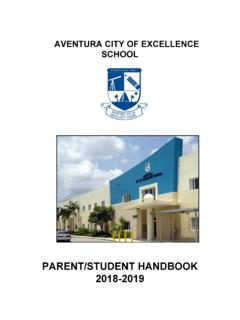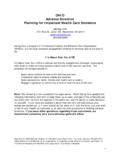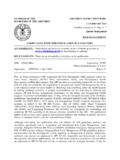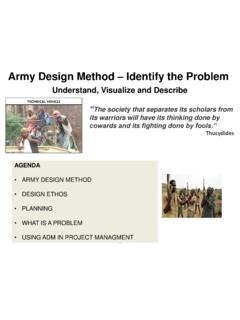Transcription of Instructional Planning & Delivery - Teaching As …
1 Instructional Planning & Delivery Copyright 2011 by Teach For America No part of this publication may be reproduced or transmitted without prior written permission from Teach For America. Titles of individuals quoted in this text were last updated 7/1/2010. Instructional Planning & Delivery Table of Contents Introduction 1 Chapter One Start with Standards 3 I. The Rationale for Standards-Based Education 4 II. How to Read the Standards 5 Chapter Three Long-Term Planning 37 I. The Purposes of a Long-Term Plan 38 II. The Four-Step Long-Term Planning Process 39 A. Use the Standards to Determine Learning Goals 39 B. Group Learning Goals Into Units 41 C. Logically Order the Units and Plot Them on the School Calendar 46 D. Continually Adjust Your Plan 48 III. FAQs on Long-Term Planning 50 Chapter Four Unit Planning 53 I. Develop Your Unit Vision 54 II.
2 Create Your Summative Unit Assessment 59 III. Translate Your Learning Goals Into Lesson Objectives 60 IV. Sequence Your Content and Scaffold Your Lesson Objectives 66 V. Schedule Your Objectives on the School Calendar 68 VI. Create Your Beginning-of-Unit Diagnostic Tool 69 VII. Create a Tracking System for Your Objectives 70 Chapter Two Student Assessment: Measuring Progress Toward Your Goals 11 I. Summative Assessment 12 II. Diagnostic Assessment 28 VIII. Continually Adjust Your Plan 72 Chapter Five Lesson Planning , Part I: Standard Lesson Structure 77 I. The Opening What Students Will Learn and Why It Is Important 79 II. Introduction to New Material The Explicit Explanation 83 III. Guided Practice 88 IV. Independent Practice 94 V. The Closing Stressing Connections and Checking for Understanding 100 Please visit the Resource Exchange on TFANet to access the Instructional Planning & Delivery Toolkit, which contains sample tools we ve collected over time that are referenced throughout this text.
3 You can also access many other tools on the Resource Exchange from a wide range of grade levels and subject areas which have been developed and shared by our corps members and alumni. Chapter Six Lesson Planning , Part II: Instructional Methods 105 I. Grouping Strategies 106 II. Whole Group Methods 108 III. Small Group Permutations 120 IV. Self-Directed Independent Work 126 V. Colleagues in Class Effectively Managing Assistants and Aides 129 Chapter Seven Lesson Planning , Part III: Making Effective Instructional Choices 133 Chapter Eight Differentiation 147 I. Differentiating Instruction 148 II. Supporting Students with Special Needs 155 III. Supporting English Language Learners 167 Grading Supplement Recording Results Effectively 175 I. Planning Your Approach 175 II. Tabulating Grades 177 III. Reporting Results to Maximize Motivation 178 Instructional Planning & Delivery Related Readings The Art of Questioning By Dennis Palmer Wolf 1 Restructuring in the Classroom: Teaching , Learning, and School Organization By Richard Elmore, Penelope Peterson, and Sarah McCarthey 8 The following additional reading should be accessed online by visiting the Pre-Institute Work page on the Institute Info Center within TFANet: Activity 1: Trying It Out By the Association for the Supervision of Curriculum Development (ASCD) 1 Instructional Planning & Delivery Introduction As we have seen in other parts of the institute, moving students toward dramatic gains in student achievement involves many things from building a powerful classroom culture to communicating effectively with students and parents.
4 Yet without effective instruction, these other aspects of teachers work won t get you very far. This course therefore aims to help you design and deliver instruction effectively. Your perceptions and assumptions about good instruction most likely stem from your own experience as a student. You probably showed up in class and saw your teachers deliver lessons, some more creatively and engagingly than others. So it may seem that instruction is about showing up and delivering lessons. Good instruction, it may seem, is about being creative and engaging. Yet this is not really the essence of instruction, or good instruction. Good instruction, most fundamentally, entails moving a class or classes of students from one place to another in their understanding or ability to do certain things.
5 When all other factors are held constant, the most successful instructors move their students the greatest distance. These instructors may in fact be the most creative teachers as well, but they won t always be. They will move their students forward most efficiently and urgently, through developing good plans, constantly assessing student progress, engaging in critical thought and reflection, and adjusting their plans to be most effective. This course aims to give you the skills and knowledge necessary to engage in this process of Instructional Planning and Delivery . Chapter One explains standards, answering the question of what you are expected to teach your students. Chapter Two focuses on assessment and the methods for determining when your students have mastered the goals you set. Chapter Three explains how to develop a year-long plan, which is the first critical step in actually reaching those goals.
6 Chapter Four shows how to develop unit plans, which go deeper in Planning instruction for a segment of the year. Chapter Five details how to develop a lesson plan that maximizes student understanding. Chapter Six provides further discussion about some of the helpful Instructional strategies that might fit into your lesson plan, and Chapter Seven shows you how to choose between those various strategies to make purposeful choices to reach your students. Finally, Chapter Eight shows how to differentiate instruction to meet the needs of individual children at different achievement levels, as well as of those who have special needs and those who are English Language Learners. At the end of this course, we hope that you will have internalized the Instructional process necessary to move your students forward as far as possible.
7 Your ultimate success as an instructor will rest on your ability to apply that process while infusing it with a high level of critical thought about how best to further your students understanding in each phase. 2 3 Start with Standards Chapter One I. The Rationale for Standards-Based Education II. How to Read the Standards Introduction The guide who leads climbers to the apex of their journey has an advantage over the classroom teacher. It is abundantly clear what the guide wants his climbers to conquer: the mountain. In the classroom, students work toward a goal but what is that goal? If you teach world geography, is the goal for your students to become geography experts? If so, what does it mean to be a geography expert? If not, is it enough for students to leave the year with a certain body of facts and skills? Which facts and skills?
8 If students can recite the geography textbook back to you, have they proven their understanding of geography? If not, how do you know when someone is proficient in geography? How do you get someone to reach that proficiency level? What if the student has a learning disability? What if the student doesn t speak English? When starting out, beginning teachers often first want to know how to engage their students, how to make lessons fun and interesting, and how to ensure that their students learn. We will get to that. But as you can see, the big questions of Instructional Planning & Delivery reach far beyond the how. They begin with the what. As improbable as it may sound, some teachers find themselves instructing for months before realizing that they have no idea what they want their students to learn. While some corps members walk into schools and receive a scripted curriculum that details exactly what they will teach every day, others are given little more than a piece of chalk and a smile.
9 Some of these teachers may say, I want my students to become better writers, but may have no idea what their students should be doing differently in June from what they re doing in September. Instead of a clear path to a chosen destination, with every day serving as another leg on the climb up the mountain, the school year becomes an aimless journey that entertains the whims of these teachers, who often worry how they re going to fill time during the day. While students might receive A s for completing what their teachers assigned, they are not necessarily better off than they were at the beginning of the year. Obviously, with many of our students far behind where they are supposed to be academically, this approach is not going to narrow the achievement gap. In fact, for the teachers who take the time to figure out exactly what their students need, filling time is no longer an issue.
10 There is so much that needs to be done. There is great urgency driving their Planning and instruction every day. This course will prepare you to understand your job as the Instructional leader of your classroom. As you read the following chapters, keep these three questions in mind: 1. What should your students know, understand, or be able to do? 2. How will your students demonstrate their mastery? 3. How will you instruct your students so they can reach that level of mastery? To be an effective teacher for your students, you must know the answers to these questions. This chapter addresses question number one. Start with Standards 4 I. The Rationale for Standards-Based Education It wasn t that long ago when teachers made most of the decisions for what their students would learn in their classes. They wrote all of the lessons. They wrote the tests. In order to graduate, students needed to meet the minimum requirements established by the individual teachers at their school.










